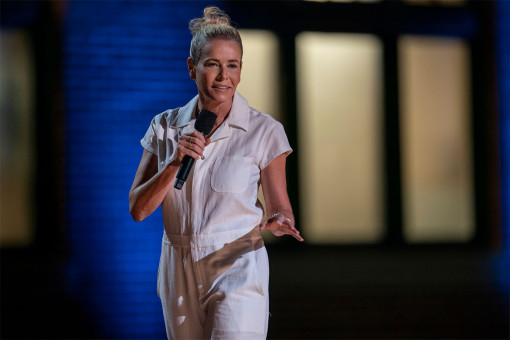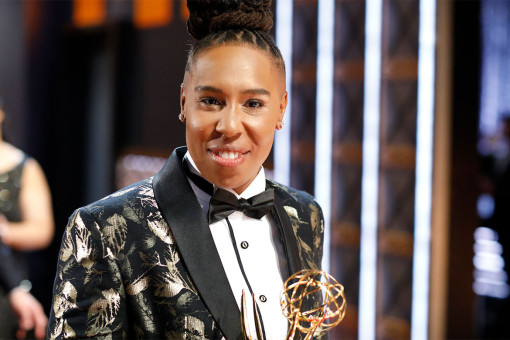Beverley Huynh's love of colorful, avant-garde fashion mixed with her theater background was the perfect concoction for a career in costume design.
Having landed in Vancouver from Calgary, her unique imagination and "sky's the limit" attitude have led the way down a successful path in the entertainment industry.
It's her admiration and respect for the characters for whom she's designing that takes it to a whole new level. Noting the subtlety in mood shifts, she reminds the actors, simply with a color change or lining their pockets with something soft, that even the toughest of characters can have a gentle side.
In addition, as an Asian woman, who was somewhat dissuaded from following these artistic dreams, she advocates for people of all walks of life to have a seat at the table.
When did you first realize you were an artist?
I knew I wanted to make clothing since I was about seven years old. Back way in the '90s, there was this TV show that would show up on Saturdays called Fashion Television from Toronto. And I used to religiously watch that every weekend.
The first time I ever came across it, I think it was a runway show for Vera Wang and I thought, "Ah, I want to do that! That's awesome!" Just these beautiful dresses and these beautiful people walking down the runway. Something about it just clicked, it made sense and I knew I needed to be doing that.
Aside from Vera Wang, who were some of your design inspirations?
I think just being a '90s kid! My parents were always working so I was kind of left to my own devices, so to speak. I would very happily just sit in front the TV and watch whatever I could possibly consume. That was basically my babysitter growing up, so I was exposed to characters and stories and fashion and media all the time. That was a big influence in my life.
My sister and I have a big age difference and she started high school when I was in junior high. She was a theater kid doing a production of Cats. She needed help with a costume and this led to her painting me with acrylic paint, wearing a leotard and some leggings!
I remember having a big laugh when we waited for the costume to dry. I took off the bodysuit and leggings and my entire skin and body were covered in white and orange and black stripes. And it was just the most fun we had in our childhood, just a sacred memory. It was one of those things that carried through in my life - that clothing and playing is just fun!
So it makes sense that this would translate into costume design.
Yes! I think it's one of the reasons I got into costume design and veered away from fashion, eventually. I did go to post secondary for fashion design and had every intent of wanting to be Alexander McQueen. To be extremely creative and avant-garde. I just loved all the things that you couldn't put on a body for sale!
I would look at those creations and think to myself, "Who on earth buys these things?" - unless you're going to the Met Gala. Like you would never wear those types of insane creations in public, unless you had some kind of grandiose party to go to!
So when I was graduating from fashion school, what I realized with costume design, was that you have so much flexibility and so much space to play in. You can go as far back into history as you could possibly want. Or the sky's the limit! Your imagination is crazy and you can just go as far into the future as you'd possibly want!
And your career, what gives you legitimacy, I suppose, and whether you were gonna crash and burn or not, didn't stand on a trend. It meant you could do whatever you wanted without too many restrictions of what's in style. That's one of the reasons I moved over to costumes because I realized my brain worked in a way that was unconventional. I didn't want to stick to a formula.
I'd imagine with sci-fi and fantasy genres, you can get even more creative?
Yes. When I get to do sci-fi projects, it's just a matter of what direction you're given and who you're collaborating with. You can pull from every walk of life and just run with it! And your vision either matches with the overall project or it doesn't. But it really gives you an opportunity to kind of test your imagination and go beyond what is just everyday wear.
You came from a theater world, where story is so important. Talk about how costumes can help tell a story.
Yes, I love when I hear little tips like when The Queen's Gambit came out. That designer modeled the final costume, the white costume for the lead character, after the queen's chess piece. I love that she took inspiration directly from something like that and just made this beautiful white coat and hat combination that just perfectly sums up the show.
As a designer, I love doing that too, putting in little psychological things to help our performers get into a certain headspace. Like if I'm working with a very callous character who has a crazy wall up, but deep down in their heart they're just protecting themselves and are actually quite warm and soft. I like to line their pockets with something soft and silky, to remind the actor, "Remember, this is your core. This is who you are."
I just love doing things like that because it gets a better performance. But then it's also a little signature or an Easter egg for myself that not a lot of people know about!
It's just little things and psychologically you may not notice it, but it just hits home because suddenly you feel colder or warmer, depending on what the story asks for. I love playing with the audience that way too - playing with colors and textures and just helping people feel a certain way. Even though they don't know what's really happening!
So it's subtle manipulation of the audience's subconscious?
A really great example is the modern remake of It. If you look at Jessica Chastain's costumes, once she gets drenched in blood, you'll see the tone of her tank top, which is such a simple costume. But you'll see the progression of this top go from a certain color and get a little browner and deeper red and muddier and grosser. All of that is the same tank top! It's just dyed six different colors as the movie progresses.
I love noticing things like that! And no one sees it except for people who actually do it. As the audience, you get these little internal feelings in your gut that something's not right. As an emotional, empathetic person myself, I really notice those things!
You referenced Jessica Chastain. Is there a particular actor or actress you'd love to design for?
Oh, there are so many! Jessica Chastain is definitely one! I'd love love love to work with Charlize Theron. She would be my dream person to put an original design on.
Charlize is one of those actresses who morphs into her characters so well, you almost don't see "her."
That would be so fun to play with! One I'd be really scared to dress is Meryl Streep! She is so amazing and she definitely morphs into every character she takes on. I've heard from many costume designers, she really steps into the costume room knowing what she has in mind and what she wants. And that would be so intimating! But if I could dive into her mind and headspace, that would be a dream come true too!
She's very tactile. I feel like she's always touching her necklaces and scarves. That might be interesting as a designer.
One hundred percent! Just things for you to feel and touch. I think, as artists too, we're quite tactile people and in the digital world, it's a little harder. Everything is through Skype, so you can say "Hey, these are the fabrics I'm thinking of and this is the color" but it's not always a true representation of what we're after.
You advocate for inclusion in Hollywood, specifically members of the AAPI community. Tell us about that.
Right now, I'm just lending my voice to as many outlets as I possibly can. I'm looking to join more groups that will have me so I can represent and understand even more. This topic is not new, but I think we're in a position now where it's a little bit safer to voice what we're fighting for.
Growing up, my sister was a big theater person, and she was discouraged from becoming an actor because she's Asian.
I think what stuck out to me as a kid was realizing that maybe we're not represented so much in front of the camera, but perhaps I can just do what I want to do behind the camera. Being told, "Don't do this, don't pursue this" because no one is going to want to see it. I think what's been wonderful lately is seeing how many people are coming out to the forefront and are sharing our Asian story.
My main focus is to teach young girls and young boys who are part of the Asian community that an artistic direction in life is not a bad thing. And that it can be valued and it can be valid. It's also teaching the older generation, as well, that these opportunities and options are available.
I think the pressure of the expectations that has been written in the narrative that "Asian people are all good at math" or whatever generalization wants to be made. It puts a lot of pressure on a younger generation and that's just something I want to change. I want the younger generation to know that an artistic life is not a bad life. You can do what you love and still be successful!
What are you working on now? What's coming up?
I just finished wrapping up a TV series called Debris that is showing on NBC. The final season of Van Helsing is just released. And what I'm currently working on, which I can't speak too much more about, is a feature for Netflix.
Lots happening at the moment and just trying to keep my head straight and remember all of them.
More articles celebrating Asian American & Pacific Islander Heritage Month.












